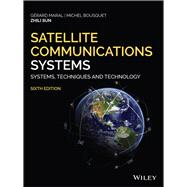The updated 6th edition of the authoritative and comprehensive textbook to the field of satellite communications engineering
The revised and updated sixth edition of Satellite Communications Systems contains information on the most recent advances related to satellite communications systems, technologies, network architectures and new requirements of services and applications. The authors – noted experts on the topic – cover the state-of-the-art satellite communication systems and technologies and examine the relevant topics concerning communication and network technologies, concepts, techniques and algorithms. New to this edition is information on internetworking with the broadband satellite systems, more intensive coverage of Ka band technologies, GEO high throughput satellite (HTS), LEO constellations and the potential to support the current new broadband Internet services as well as future developments for global information infrastructure.
The authors offer details on digital communication systems and broadband networks in order to provide high-level researchers and professional engineers an authoritative reference. In addition, the book is designed in a user-friendly format. This important text:
- Puts the focus on satellite communications and networks as well as the related applications and services
- Provides an essential, comprehensive and authoritative updated guide to the topic
- Contains new topics including the space segment, ground, ground satellite control and network management, relevant terrestrial networks and more
- Includes helpful illustrations, tables and problems to enhance learning
- Offers a summary at the beginning of each chapter to help understand the concepts and principles discussed
Written for research students studying or researching in the areas related to satellite communications systems and networks, the updated sixth edition of Satellite Communications Systems offers an essential guide to the most recent developments in the field of satellite communications engineering and references to international standards.








